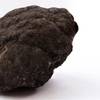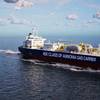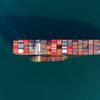By Larry Pearson
The movement of petroleum products on the nation's rivers, lakes, bays and oceans is soon to be regulated of the Oil Pollution Act of 1990. Called OPA 90, this regulation requires many bulk carriers of petroleum products to use double-hulled barges to haul their cargo by 2005 and all to be doubled hulled by 2015.
Looking first at the large product tankers and crude oil carriers, 23 product carriers and 17 crude oil carriers must be double hulled by 2005, another 20 product carriers and 17 crude oil tankers need to be double hulled by 2010 and another 13 product and 9 crude oil ships need to meet OPA 90 by 2015. These conversions (or ship retirements) are a major issue impacting the ability of the U.S. to transport crude oil and its refined products.
In the smaller dwt vessel categories, many companies have been anticipating these regulations and have been ordering double hulled barges and ATB's in record number and also "double skinning" existing barges in their fleets.
This high level of construction activity for double-hulled barges is also in response to warnings issued by several maritime groups predicting a shortage of these vessels. For example, The Shipbuilders' Council in an October 3, 2001 statement said, "Construction of double hulled vessels must increase dramatically to avoid a shortage of U.S. flagged ships. It is anticipated that the demand could exceed supply by as much as 24% in the next three years."
Several major shipyards have contracts for ATB's and double-hulled barges.
Alabama Shipyard
Alabama Shipyard recently delivered a 143,000 barrel, 487- ft. OPA 90 compliant barge fitted with a 124-ft., 7,200 hp tug to Reinauer Transportation Companies of Staten Island, NY. Christian Reinauer, director of new construction for Reinauer Transportation said the ATB's carry "clean" petroleum products such as gasoline, kerosene, diesel fuel, jet fuel, home heating oil and similar products. Reinauer operates a fleet of over 75 vessels on routes from Maine to Florida.
Ocean Tug & Barge Engineering (OT&BE), of Milford, Ma., wrote the specifications for the RTC 145.
'This is our second ATB, both built by Alabama Shipyard," Reinauer said. "We found that our first ATB was faster, more efficient and not subject to bad weather delay so we are expecting the same advantages from our second unit," Reinauer added.
"These are bottom line issues to us," Reinauer observed.
Reinauer's second ATB from Alabama Shipyard is larger than the first. The double hulled barge is 487 ft. long, 27 ft. longer than the first barge and can hold 143,000 barrels of petroleum products versus 135,00 barrels for the first barge. The two tugs are essentially the same at 124 feet long and 7,200 hp powered by twins screws.
The tug/barge units feature a coupling system designed and built by Intercontinental Engineering and Manufacturing Corporation of Kansas City. Called the "Intercon Coupler System," the aft end of the barge is notched to accept mating of the tug and the barge. Two independently mounted gear drive ram assemblies connect the tug and the barge.
The connection is transversally rigid and mechanically locked as the tug and barge act as a single unit as would a conventional ship without this connection. The result is a vessel that is faster, eliminates towing lines and can be coupled and uncoupled without a deck crew. As noted by Reinauer, the vessel can operate in a wide range of sea states.
All ATB's being built today comply with the Oil Pollution Act of 1990 (OPA-90) which essentially has set a deadline of 2005 for large coastal barges to be double hulled.
Also under construction at Alabama Shipyard is a 129,000 barrel ATB that will be pushed by an 8,000 HP tug for Allied Transportation. Penn Maritime has also ordered a 129,000-barrel double skinned barge.
The Manitowoc Co.
Vessel Management Services, Inc. (VMS) of Seattle, Wash., is very active in purchasing ATB's. The Manitowoc Company, Manitowoc, Wisc. has received a contract from VMS for two such units. The double hulled barges will hold 155,000 barrels of petroleum products and be pushed by 9,280 hp tugs. Manitowoc Company's marine division consists of four shipyards. Two such yards will be involved with the AB contract. The tugs will be built at the Marinette Marine facility that has superior vessel building and outfitting skills. Bay Shipbuilding will construct the barges utilizing their steel fabrication and "big ship" skills.
Bollinger Shipyards
Bollinger Shipyards, Lockport, La., is keeping several of its shipyards busy with double hull barge and ATB contracts.
At Bollinger Gretna LLC in Harvey, La. the company is a few weeks from delivering the first of four double hull, ocean service petroleum barges for K-Sea Transportation Company of Staten Island, NY. The barges will meet OPA 90 requirements and will have capacities from 80,000 to 100,000 barrels.
K-Sea operates a fleet of over 60 barges and tugs and is one of the largest operators in the Northeast. These four barges will replace older units being phased by 2005 out due to OPA 90 legislation. The company transports black oil, bunker fuel and several grades of "clean" oil such as gasoline, kerosene, diesel fuel and other similar products, according to Tom Sullivan, director of operations.
Acomarin Engineering of Finland manufactures the coupler between the new built barges and the existing tugs owned by K-Sea. "It's called the JAK Coupler System," said Sullivan. "It is pneumatic rather than hydraulic so its lighter and can secure a larger range of our existing tugs," Sullivan explained.
"We are using a center line bulkhead with five compartments on each side of the bulkhead permitting us to carry a wider range of cargos," Sullivan added.
Bollinger is using two of its shipyards to maximum advantage in this project. Bollinger Marine Fabricators in Amelia, La., is fabricating the modules for the barges. The modules are shipped to Bollinger-Gretna where they are being joined and having other systems and components made by Bollinger-Gretna added.
The new barges feature double block cargo segregation, segregated ballast, cargo monitoring and vapor recovery capability. The first barge, a 100,000-barrel unit, will be delivered by Bollinger-Gretna during the summer of 2002.
Bollinger has significantly increased its production capacity to build double hulled barges. It has doubled the workforce at Bollinger-Gretna to 180 people and greatly increased its production capacity to build barge modules at Bollinger Marine Fabricators in Amelia, La.
Bollinger began the year with a contract for two ATB's from Bouchard Coastwise Management Corp., Hicksville, NY. Designed by Guarino & Cox, LLC, naval architects and marine designers of Slidell, La., the contract calls for two 6,000 HP tugs and OPA 90 compliant double-hulled barges of 110,000 barrel and 135,000 barrel capacities.
Bouchard is a new customer of Bollinger, but not a new customer of the Bollinger-Gretna shipyard and many of its management and production personnel. Bouchard had several OPA 90 compliant barges built at the yard when it was known as Gretna Machine & Iron Works. Bollinger bought the yard in August 2000.
The barge modules will be built at Bollinger's main new construction facility and home office in Lockport, La. As with the K-Sea barges, the modules will be shipped to Bollinger-Gretna for final assembly and fit out.
The first barge will be 430 ft. long with a 79-ft. beam and a 34-ft. depth. Barge 2 will be slightly larger at 487 ft. long with an 80-ft. beam and 36.6-ft. depth. The stern on both barges will be notched and a vertical ladder structure installed as an integral part of the Intercon tug/barge coupler system.
The tugs will be 130 ft. in length with a 38-ft. beam and each powered by a pair of EMD engines rated at 3,070 hp each. The first ATB unit is scheduled for delivery in the second quarter of 2003 and the second unit a year later.
Halter Marine
Halter is building two ATB units for Vessel Management Services of Seattle with options for four additional units. All are 150,000-barrel OPA-compliant barges with 9,280-hp tugs.
The tugs are being built at Halter's Gulfport shipyard and the barges at Moss Point Marine shipyard in Escatawpa, Miss.
Also on Halter's order book is an 80,000-barrel double-hulled barge for an undisclosed buyer. This barge will be 332 ft. long, 74 ft. wide and 25 ft. deep. Work also continues on the double skinning of an existing barge for Bouchard Coastwise Management Corp.
Shuttle Tanker
Barges and ATB's move refined petroleum products, but there is looming a big crisis farther back the supply chain. It is moving crude oil from the rigs to the refineries. There are basically two ways of moving the basic oil product…via pipeline or tanker.
Up to now most of the oil discoveries have been on the continental shelf … close enough to shore for pipelines to do the job.
Now with the emphasis on drilling in deeper water farther from shore, pipelines are a much less attractive alternative. The greater distances and rougher Gulf floor topography in deeper water are making pipelines too expensive and in some cases technologically impossible.
Hence the rise of the shuttle tanker. Tankers to shuttle oil from offshore oil fields to shore have been used in the North Sea for years, and are being looked at very carefully to transport oil in the Gulf of Mexico. Recently a joint venture between oil producing giant Conoco, shipbuilder Alabama Shipyard and tanker designer Samsung Heavy Industries of Korea.
Tim Berkel of Alabama Shipyard is one of the driving forces behind this development.
"Right now we are in the design and development phase," Berkel said. There is no doubt that this is a viable concept…one that will move large amounts of oil from the remote parts of the Gulf of Mexico 150 to 200 miles from shore to land based facilities," Berkel added.
The planned capacity of these vessels is 500,000 barrels of crude oil in a vessel with less than 40-ft. draft so it can dock at a majority of ports. These vessels will have to be Jones Act compliant since an oil platform is considered a U. S. port. "We may need as many as 15 of these vessels within the next several years," Berkel said.
Berkel's comments may be conservative. There is no question that we will need dozens of all types of petroleum carriers to meet the 2005, 2010 and 2015 deadlines imposed by OPA 90. (By Larry Pearson)
Sponsored Content
ALMACO Group Completes Extensive Refurbishment on The Aroya

How mobile data informs safety and efficiency onboard and ashore

March 2025
 Read the Magazine
Read the Magazine

 Read the Magazine
Read the Magazine
This issue sponsored by:

Ship Design Evolution & The Mother of Monster Waves
Subscribe for
Maritime Reporter E-News
Maritime Reporter E-News is the maritime industry's largest circulation and most authoritative ENews Service, delivered to your Email five times per week










